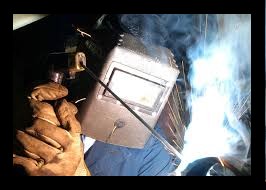Arc Welding with Coated Electrode
Arc welding is carried out by striking an arc between a rod electrode and the workpiece, thus simultaneously heating the workpiece and melting the electrode, which supplies filler metal for the joint. The power supply used In welding with coated electrodes consists of a DC or AC source with a dropping characteristic.
Arc welding was first applied using uncoated steel wire, but the welds so produced are brittle due to high oxygen and nitrogen contents. In modem practice, virtually all metallic arc welding electrodes are coated with a substantial thickness of fluxing material. The functions of the coating are:
To provide a suitable gaseous atmosphere for the arc and weld pool;
To produce a slag which will;
Give additional shielding to the weld pool
refine the molten weld metal and
assist the manipulation of the weld pool during welding.
act as a carrier of ferroalloys, de-oxidants and Iron powder.
Produce the desired arc and metal transfer characteristics
Coatings consist of certain essential organic or mineral components and Ferro-alloys, that are bonded into a past with clay, mica, and sodium or potassium silicate and applied to the electrode wire by extrusion or by dipping the wire into the paste. They are subsequently baked; when moisture Is driven and the coating hardens.
The four main types of coating for carbon steel electrodes are there. The arc atmosphere and volume of gas produced by the rutile coated electrode are very much similar to that of cellulosic type, but the manipulative characteristics differ, in particular, rutile-coated electrodes do not penetrate so deeply for a given thickness of the coating.
Iron oxide coated rods develop a protective atmosphere of similar composition to that of cellulosic and rattle types, but at about half the volumetric rate, and thus depend '" part on a slag covering for protection of the weld pool.
Basic coated or low-hydrogen electrode h ve a coating which .contains calcium carbonate, fluorspar, bonding agents, de-oxidants and are baked at high temperature (400-450°C) to drive off nearly all the combined moisture. The arc heat caused break- down of the calcium carbonate, and the arc atmosphere consists almost entirely of a mixture of carbon monoxide and carbon dioxide. The rate of gas evolution Is substantially lower than that associated with rutile or cellulosic types, In this fact, associated with the less reducing character of the CO-CO2 mixture, it makes it less protective. It is necessary therefore to maintain a short arc when welding with basic electrodes to avoid oxygen and nitrogen contamination of the weld pool and consequent porosity.
An excessive amount of hydrogen dissolved In eld metal causes embrittlement of certain
medium-carbon, high carbon and allow steels In the weld and heat-affected zone. The amount of hydrogen In the weld depends on the partial pressure of hydrogen in the arc atmosphere. The hydrogen content Is damaging to hydrogen sensitive materials. Basic coated electrodes
(provided they are dry when used) give weld deposits having relatively low hydrogen content,
and are therefore preferred for alloy and high tensile steels.
The arc characteristics may be modified by a diting easily ionizable metals to the
coating. In particular, the use of potassium silicate as a binder Instead of sodium silicate results In the presence of potassium ion in the arc column, which facilitates re-ignition of the arc after an interruption of current. Therefore, potassium silicate Is added to coating for AC welding and sodium silicate DC electrodes. Alternating current is used for welding carbon, low alloy and some high alloy steel with coated electrodes. Non-ferrous electrodes generally require DC although AC may be preferred because the power source is less costly. But for high-quality work or alloy steel, DC Is generally employed.
The nature of the coating also aff its metal transfer. Cellulosic, rutile and basic coating give short circuit transfer whereas the transfer from iron oxide coated electrodes tends to be projected. As the thickness of the coating is increased, so the weld pool becomes deeper and narrower and the electrode is said to have deep penetration characteristics. Electrodes with very thick coatings are used for cutting metals.
A substantial amount of alloying elements are sometimes added to the coating, so that the composition of the deposited metal may differ from that of the core wire. The iron powder may also be added to electrode coating in amounts that vary from 10 to 50% of the .coating weight. The metal deposition rate obtained from this type of electrode is superior to that of normal grades and is particularly suitable for high-speed welding on the down hand position.
Manual welding with coated electrodes Is at present the most widely used welding process,
a high proportion of the steel welded in India being joined in this way. It Is a versatile process applicable to carbon, low-alloy and most high ally steels, cast iron, nickel, and nickel alloys, and to some degree to an aluminum alloy, tin bronze, and aluminum bronze. Coated electrodes are not suitable for welding pure aluminum, pure copper, the low melting point metals, or the reactive metals.




No comments:
Post a Comment
Please do not enter any spam link in the comment box